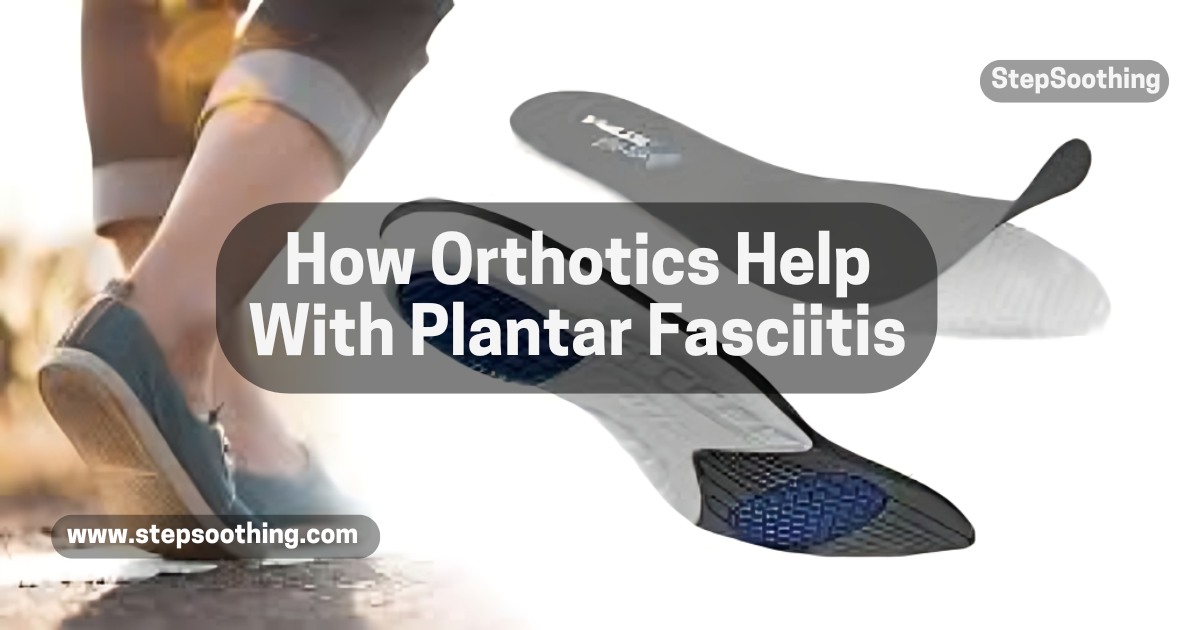Dealing with plantar fasciitis can be a real challenge, especially when it causes serious pain in the heel. In the United States, over 1 million people visit outpatient clinics annually for this condition. Research shows that custom orthotics can significantly help reduce the symptoms. These shoe inserts, crafted by specialists like David Biss, DPM, a board-certified podiatrist from Concord Podiatry in Plymouth, New Hampshire, offer tailored solutions to alleviate discomfort.
The custom-fitting process for orthotics involves detailed evaluation by a podiatrist’s team to ensure they relieve the specific pain associated with plantar fasciitis. By providing proper support and addressing the root causes of heel pain, these orthotics can greatly improve your quality of life.

About Plantar Fasciitis
Plantar fasciitis is a common cause of heel pain that happens due to inflammation of the thick tissue at the bottom of the foot. This tissue, called the plantar fascia, connects the toes to the heel and supports the arch. People often feel a stabbing pain in the morning or after standing for long periods. Activities like walking, running, or dancing can increase tension and lead to small tears in the tissue.
Risk factors for plantar fasciitis include being 40 to 60 years old, having flat feet, or having high arches. Obesity, stress, and activities such as long-distance running can also contribute. Genetics and abnormal foot patterns might make some people more prone to this condition. To reduce symptoms, one might need to modify their activities, lose weight, or see a podiatrist for stretches or prescription orthotics. Surgery is a last resort if other treatments don’t work.
How Custom Orthotics can help with Plantar Fasciitis
Custom orthotics are crafted specifically for your feet by a podiatrist. They are designed to offer support and comfort where it’s needed most. A podiatrist evaluates your gait and foot problems to create custom-designed orthotics that fit perfectly and correct biomechanical problems. Unlike prefabricated insoles, custom orthotics use high-quality technology and materials to provide a variety of benefits, including relieving pressure on the plantar fascia and correcting foot function.
Although custom orthotics come with a higher price tag, they are long-lasting and tailored to address specific issues like heel pain and soft tissue problems. They can dramatically decrease plantar fasciitis pain by ensuring that the foot is properly aligned and stopping overstretching of the plantar fascia. For best results, it is essential to wear them regularly and get used to their support, as Concord Podiatry emphasizes during your appointment.

Orthotics and Insoles for Plantar Fasciitis: Do they help, and are they worth it?
What are Orthotics and Insoles?
Orthotics and insoles are special shoe inserts designed to treat painful foot conditions like plantar fasciitis. Whether you are an athlete or a non-athlete, these inserts offer support and protect your feet while helping to enhance natural foot function. They come in various shapes, sizes, firmness, and flexibility to meet different needs.
These inserts are made from various materials such as EVAs (ethyl-vinyl acetates), rubber-like substances, gel, foams, cork, and moldable plastics, and even carbon fiber. Each material has its own unique properties, providing different levels of cushioning and support to improve your comfort and foot health.
Are Insoles the same as Orthotics?
Insoles and orthotics are both types of shoe inserts, but they serve different purposes. Insoles are generally adapted to offer basic support and comfort, while orthotics are designed to provide more specific benefits for foot issues. Orthotics often involve a type of insole with a tailored fit to address specific foot problems, making it important to avoid confusion between the two.
Different types of Insoles
Insoles are divided into 2 types: Supportive and Unsupportive.
Supportive insoles offer features like arch support and cushioning, which can be beneficial for conditions like plantar fasciitis. On the other hand, unsupportive insoles are often categorized by their materials and functions and may be easier to get but provide less targeted relief. Each type of insole serves a different purpose, so choosing the right one depends on your specific needs.

Unsupportive Insoles and Shoe Inserts
Unsupportive insoles include soft insoles, accommodative insoles, and various shoe inserts such as gel heel pads and gel heel cups. Made from soft materials like fabric, foam, and gel, these options are often cheap and easy to find. They come in shapes and sizes that can fit most shoes. While they provide a cushioning effect and are generally comfortable, they usually lack arch support insoles and can compress or lose shape with regular use.
Although these inserts can protect the heelbone and potentially improve foot function, they often offer limited support for plantar fasciitis. There is no evidence that they significantly alleviate symptoms or contribute to long-term relief. Their primary benefit may be temporary comfort rather than a solution to plantar fasciitis issues.
Do Gel Heel Pads and Cups help Plantar Fasciitis?
Gel heel pads and gel heel cups are often recommended to help with heel pain caused by plantar fasciitis. They can be beneficial because they provide extra cushioning for the heel. Made from gel, these products act as a shock absorber and can protect the heel bone and fat pad. They may reduce pressure on the plantar fascia and help ease soreness.
However, the effectiveness of gel heel pads for plantar fasciitis is debated. Some researchers argue that the fat pad naturally decreases with age or overuse, becoming less thick. This can lead to heel spurs, a small bony projection on the underside of the heel bone. While gel pads can help cushion the heel, they might not address underlying issues or provide evidence of long-term relief. The thinner fat pad can sometimes be wrongly blamed for plantar fasciitis pain.
When might Gel Heel Pads or Heel Cups not be that useful?
Gel heel pads and heel cups might not be very helpful if your heel pain is due to a lack of stability or control in your foot. These products mainly offer heel cushioning but do not address issues related to the ankle or provide support like some supportive insoles. If your problem is more about the overall support or alignment of your foot, then gel pads might not make a difference compared to more supportive insoles. In such cases, unsupportive insoles might not be enough to manage or relieve the pain.

Supportive Orthotic Insoles
Supportive orthotic insoles can be a game-changer for managing plantar fasciitis. Unlike prefabricated insoles, orthotics are specially designed to offer support and address specific foot issues. While custom insoles are tailored to fit your unique needs, rigid functional orthotics provide firm support that helps in reducing heel pain and correcting foot mechanics. These insoles are more effective than general shoe inserts because they are crafted to provide functionality and relief for those suffering from plantar fasciitis.
Function and Features of Supportive Insoles:
Supportive insoles are essential for plantar fasciitis as they provide extra support to your feet. Their design often includes features like arch support and shock absorption, which help in cushioning and reducing heel pain. They also offer firmness and can include a metatarsal lift for added comfort. Some insoles even control supination and combine various features to address multiple foot issues, ensuring a good balance of support and cushioning.
Prefabricated Insoles
Prefabricated insoles, also known as premade insoles, are readily available and come in various materials. They can be hard, soft, firm, or flexible, offering a combination of features to meet different needs. These insoles are less expensive compared to custom insoles and are easy to find. However, they may not always provide the perfect fit or support required for specific conditions like plantar fasciitis. When choosing prefabricated insoles, consider the type and materials to ensure they offer the right balance of support and comfort.

Main features and Functions of Prefabricated Insoles
Prefabricated insoles come in a range of designs and are often non-customized. They can be cut to size and are generally generic, meaning they offer distinct levels of cushioning and arch support to suit various foot types and shoe types. These insoles can be useful for general conditions and offer a convenient option for different shoes. Depending on the materials used, they may be soft and comfortable, but typically last from 6 months to 2 years. While they provide cushioning and basic support, they may not match the personalized benefits of custom insoles.
Do Prefabricated Insoles help for Plantar Fasciitis?
Prefabricated insoles might offer some benefit for plantar fasciitis, but available research suggests they may not provide the extra benefit of high quality custom insoles. While they are a common treatment and can be useful for cushioning and support, better studies and reliable conclusions are still needed to fully understand their effectiveness. Heel pads and other types of prefabricated insoles can offer temporary relief, but results may vary between patients. For those looking for a more specific solution, it may be worth considering options beyond the generic choices available.
When to use Prefabricated Insoles
Prefabricated insoles can be a practical choice if you need arch support and cushioning without spending a lot of money. They are useful for providing support and reducing strain on the plantar fascia, which can help manage pain and aid in the recovery process. However, they may not be as effective as custom options for more severe issues. Use them if you’re looking for a cost-effective way to alleviate discomfort and improve comfort in your daily activities.
Custom insoles or rigid functional orthotics
Custom insoles are crafted with unique materials to fit your prescribed level of support and cushioning. They are expensive and may take 2 to 4 weeks to make due to the specialist fitting and manufacturing required. However, their tailored design can provide precise relief for plantar fasciitis. Rigid functional orthotics, on the other hand, offer strong support and control, which might be beneficial depending on your specific needs. Both options require access to a specialist for optimal results.

Main features and functions of custom insoles
Custom insoles are crafted based on an individual assessment by a podiatrist, considering your foot structure, walking pattern, and shoe type. They are customized through precise methods like using a cast or a foot scanner, ensuring they fit your feet perfectly. These insoles are made from unique materials and are designed to be longer lasting, with some shells providing support for 2 to 5 years and covers lasting up to 2 years.
Unlike prefabricated insoles, custom insoles are built to control joint motion and maintain optimal foot alignment without changing shape. This makes them a valuable choice for addressing plantar fasciitis, as they offer consistent support and cushioning tailored to your specific needs.
Do orthotics help plantar fasciitis?
Custom orthotics can be effective in managing plantar fasciitis, especially in the short term. Research shows that using custom orthotics might help improve pain during the first 12 weeks of treatment. They are often found to be slightly better than prefabricated insoles in providing targeted support and relief. However, the benefits of custom orthotics tend to not go beyond the initial few months, so it’s important to combine their use with other treatments for lasting results.
When to use custom insoles or orthotics
Custom insoles are a good option when prefabricated insoles don’t deliver the positive results you need for managing plantar fasciitis. They offer a glove-like fitting tailored to your foot shape, making them longer-lasting and more effective, especially for those with flat arches or stiff high arches. If you have feet less flexible or require more specialized support, experts may recommend custom insoles as the next step. They help control foot movement and are designed to complement other treatments like taping, exercises, and load management.
What type of insoles is best for plantar fasciitis?
When choosing the best type of insoles for plantar fasciitis, the options can be overwhelming. A one-size-fits-all option might seem convenient, but it may not address your unique symptoms effectively. The sheer variety of insoles and varying theories about their effectiveness make it unclear which type truly works best for everyone. There is unclear evidence about which specific type is ideal, as what works for one person might not work for another. Therefore, it’s important to consider your situation and possibly consult with a specialist to find the most suitable insoles for your plantar fasciitis.
Why do insoles work for some people with plantar fasciitis and not for others?
Insoles can be a puzzle for treating plantar fasciitis because they may work for some but not for others. This is due to the multiple causes of plantar fasciitis which make it hard to predict how well insoles will perform. A firmer supportive insole may be better for those with thin fat pads or specific foot function issues, while a softer gel insoles might work for others. The root causes of the pain and specific case of each person will determine which type of insoles or orthotics is best. What works for one person may be unrelated to another’s needs, highlighting the need for a personalized approach when choosing the right support.
Frequently Asked Questions
Are plantar fasciitis insoles effective?
Yes, insoles can be quite effective. Both prefabricated and custom fitted orthotics often help to reduce pain and improve function in people with acute plantar fasciitis. They have few risks and side effects.
How long does it take for plantar fasciitis insoles to work?
It can take 6-18 months to see improvement with orthotics. For some, plantar fasciitis may be chronic, and pain might improve or even heal slowly, depending on the individual case.
What is the best foot support for plantar fasciitis?
For plantar fasciitis, Tread Labs Pace insoles are recommended. They provide firm, medical grade support, a precise fit that matches the contours of your foot, and a deep heel cup to support your plantar fascia effectively.
What not to do with plantar fasciitis?
Avoid movements that place excessive stress on the heel and arch, such as running, jumping, or standing for prolonged periods. Walking on hard surfaces without supportive footwear can also exacerbate the condition.
Is plantar fasciitis hard to get rid of?
Plantar fasciitis often improves with stretching over months. If symptoms persist after two months of treatment, your doctor might suggest steroid injections to decrease inflammation.



